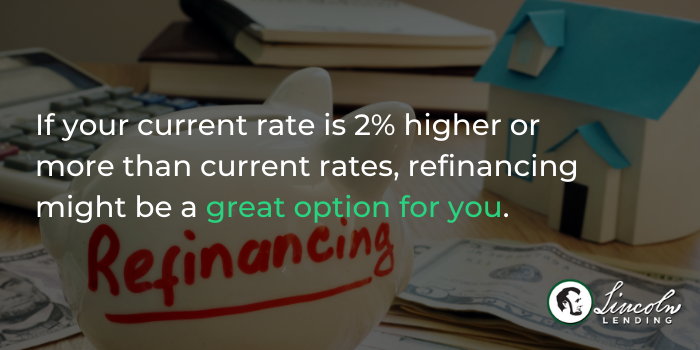If you’re like most homeowners, you’ve watched loan interest rates drop over the past couple of years and wondered whether refinancing could save you money. How do you know if you’re a good candidate for refinancing? In this article, we’ll discuss why rates are low and how it benefits homeowners.
What is Refinancing?
When you refinance your mortgage, you pay off your existing mortgage with a new home loan that has better terms. Your new loan may have a shorter duration or more favorable interest rates.
The process of refinancing is the same as securing your original home loan. Homeowners still have to pay fees for an appraisal, title, insurance, and closing costs. However, your savings from the new loan should offset those additional costs within a few years.
Is Now the Best Time to Refinance?
At the close of business each day, the Federal Reserve requires banks to have a certain dollar amount of cash in reserve. As bank account holders spend money throughout the day, the bank’s cash holdings fluctuate. Often, banks need to acquire a short-term loan to meet their nightly reserve requirement. The solution? To borrow money from other banks.
Just as banks charge interest to consumers who take out loans for homes or cars, banks charge interest to one another for these short-term loans. The interest rate that banks charge each other is called the federal funds rate.
When people talk about the Federal Reserve raising or lowering rates, what they really mean is that the Fed is raising or lowering its target range for the federal funds rate. The Fed uses several techniques to achieve its target rate, including changing the discount rate, which is the interest rate at which banks can borrow cash directly from the Federal Reserve.
For example, when the Fed wants to lower rates, it might lower its discount rate. As a result, banks are incentivized to lower the interest rate that they charge one another to stay competitive with the Fed.
What does all of this mean for homeowners? When a bank pays less on its short-term loan interest, it can afford to charge its customers less on interest for things like home mortgages. That’s why home mortgage rates tend to rise and fall with the Fed rate. 
The Federal Reserve has been steadily lowering its rates since 2018. Home mortgage interest rates are currently the lowest that they’ve been in a decade, and they are very near historic lows. This is great news for home loan holders. The mortgage interest rate isn’t likely to drop further (banks need to mitigate their risk because rates will invariably rise in the future), which means that you may not find a better time to refinance than right now.
Benefits of Refinancing
Before refinancing, consider your goals. Are you hoping to get a lower interest rate, reduce your monthly payment, or shorten the duration of your loan?
Lower Your Rate
A reduced interest rate can save quite a bit of money over the course of a loan. However, the new rate needs to be at least 1% lower than your current loan to offset the costs of refinancing. If your current rate is 2% higher or more than current rates, refinancing might be a great option for you.

Reduce Your Monthly Mortgage Payment
After paying on a loan for several years, your principal balance will decrease. When you take out a new 30-year loan with a lower interest rate, your monthly payment will be lower than it was on the original loan.
Shorten Your Loan Term
Another way to refinance is to trade in a 30-year mortgage for a 15-year loan. Often, shorter-term loans offer lower interest rates, but they usually come with higher monthly payments.
You could also do a “faux” refinance by making double mortgage payments on your existing loan each month. If your financial situation changes, you retain the freedom to lower your monthly payments. Plus, it doesn’t require that you take out a new loan and pay the accompanying fees.
Change Your Loan Type
If your existing mortgage has a variable-rate, you may want to refinance to a fixed-rate mortgage to lock in the current low rates. While the rates may stay low for a while, they won’t last forever. If ever you wanted to lock in a low interest rate, now is the time.
It’s NOT the Right Time to Refinance If…
Not every mortgage is a good candidate for refinancing. If, for example, you’d only lower your interest rate by 0.5%, you aren’t likely to save enough to cover the cost of the refinancing fees. It also may not be wise to refinance are if:
- Your mortgage has a prepayment penalty – check with your lender to learn whether you face a fee for early payments. The penalty may offset the benefits of a new, lower interest rate.
- You are planning to move soon – it takes a few years to recover the cost of the refinancing fees, so homeowners who will sell their home soon are not great candidates for refinancing.
- The value of your home has fallen – it may be difficult to secure a new loan if the balance of your existing loan is greater than the market value of your home.
- You have a home equity loan or line of credit – your home equity lender may have to approve your refinance, or you may need to pay off your equity line either before or as a part of the refinance.

Every Situation is Unique
You may want to start your refinancing decision with a simple mortgage calculator. If it seems like refinancing might be a good idea for you, get in touch with our loan specialists. We can help you evaluate your refinance goals and perform some initial basic calculations without charging any fees or pulling your credit.
Our initial assessment will help determine whether or not the potential savings from refinancing is significant enough for you to go through the process. With a minimal time commitment upfront, together, we can decide which refinancing opportunity, if any, is best for you.

